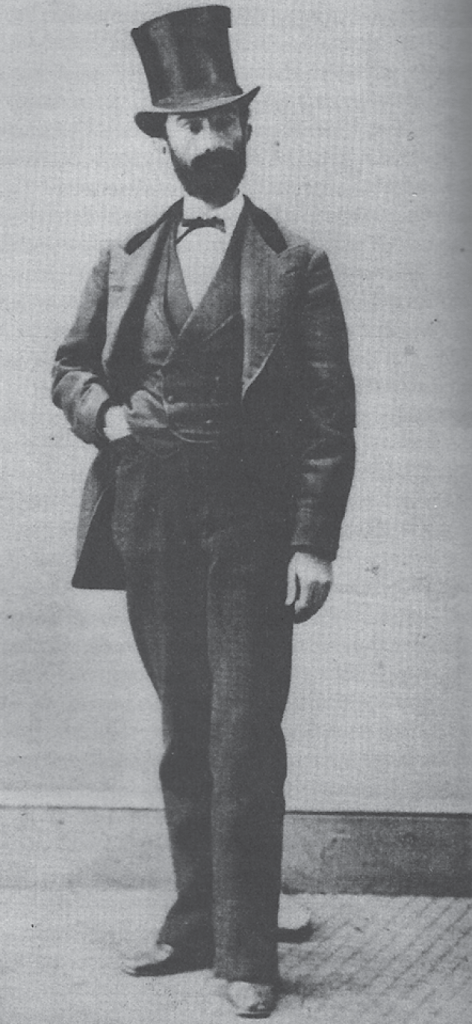By Mary Lowers.
Saguache, the unique name few who are not from this area can pronounce means “blue water” in the Ute language. The blue water in question was a particularly beautiful fresh water spring about twenty miles west of the current Saguache town site. The spring waters rose from a basin of blue hued earth. In her history of the valley, Virginia McConnell Simmons writes “Traders and Indians are known to have camped together harmoniously several times at the spring off Saguache Creek. This location was one of the most popular and beautiful Ute Camps.” In the Ute language the camp was named Saguguachipa which became Saguache (pronounced sa-WATCH) because the non-Utes visiting there could not correctly spell or pronounce the name.
By 1865 the first treaty with the Ute Nation in Colorado was negotiated, and an immigrant settlement of the northern San Luis Valley (SLV) well underway. The diverse group of immigrants included northern European immigrants, displaced Anglo-Americans moving west after the American Civil War, and Mexicans who had populated southern Colorado in increasing numbers after Mexican independence from Spain in 1821. They became Americans by default after the end of the Mexican American War with the Treaty of Guadalupe Hidalgo in 1847. Several families of soldiers from the First Colorado Regiment took up homesteads in the northwest side of the SLV. The first settlement in the Saguache area was called Lawrence after early settler John Lawrence, who was instrumental in the formation of Saguache County in 186.
John Lawrence, Otto Mears, Isaac Gotthelf, Nathan Russell, Leopold Mayer and David Heimberger could be considered the founding fathers of Saguache. In 1874 these men and the closeknit Saguache community formed a town company in anticipation of growth and development. This original development of the Town of Saguache is forever linked with increasing marginalization of the Ute people in the state. The treaty of 1868 with the Ute placed their territory in an area of southwestern Colorado, which equaled a third of the territory of the state. The Ute were promised one hundred and sixty acres of land per family.
As prospectors began to discover the treasure trove of valuable minerals, Indigenous residents of the state were shoved out of their traditional territories to the far western regions of Colorado. The Brunot Agreement of 1873 accelerated non-native settlement in the SLV by removing a large part of Ute territory in the San Juan Mountains from Saguache to Lake City. When this and other treaty specifics were disputed, Colorado Territorial Governor Edward M. McCook said he was unable “to comprehend the reasons which induced the Colorado officials and general government to enter into a treaty setting apart one third of the whole area of Colorado for the exclusive use and occupation of the Ute nation. I do not believe in donating to these indolent savages the best portion of my territory.”
Among the founders of Saguache, Otto Mears was a Russian Jew who served in the Union Army for three years. Part of this hitch in the service was a stint with Kit Carson’s campaign against the Navajo. Upon leaving the army Mears landed in Santa Fe, New Mexico where he clerked at a general store, working his way up to manager. He became a partner in the business and was moved up to Conejos, Colorado in the SLV. Mears operated a general store in the settlement of Guadalupe. Farmers in the Conejos region were unable to grow enough wheat for Mears to mill. This and getting the government contract to supply the Los Pinos Indian Agency, then located near Conejos which served the Ute reservation in the SLV prompted Mears to move north in 1866. In 1868 the Los Pinos Indian Agency for which Mears was the Ute supply agent was moved to the west side of Cochetopa Pass. The territorial government explained this change stating, “We do not want the Indians too close to white settlement for their comfort.” Mears was a so-called “good” agent who did not rip off his Ute clients. He became friends with famous Ute leader Ouray.
Mears felt he could grow wheat of the quality and quantity he wanted in the Saguache area for the mill he’d left in Conejos. He was also closer to his Ute clients after the Burnot Agreement moved their territory westward. The first mower, reaper, and thresher machines in the SLV were brought here by Mears. Prior to this wheat grown in the area was hand harvested with a sickle and was often threshed by sheep walking back and forth over the cut crop.

In December of 1866 Saguache County was created from the portion of Costilla County lying north of the Sangre de Cristo Land Grant. Mears served as the first County Treasurer. John Lawrence moved north from Conejos in 1867. Despite his unique spelling, his forty years of journal entries give much insight and color to the story of Saguache, which was originally called Lawrence. He had the ability to create community. The first day Lawrence spent in the Saguache area he went to connect with good old friends. Virginia McConnell Simons describes this beautifully. “When he went over to the Mexican Camp to visit a family he knew in Conejos, he found out an old man in their outfit had died. The usual procedures of a proper burial did not seem to be on anyone’s mind, so Lawrence took charge of affairs. He got Harrie to build a coffin. Then he chose a site on a ‘nole’ south of the river for the burying grounds and graveyard.” On day two Lawrence dug the old man’s grave.
During his long life in Saguache, Lawrence was a state representative, county assessor, county judge, and a member of the school board for twenty years. Lawrence built roads, raised wheat and sheep. He left the sheep to Mexican friends in his will.
Early Saguache settler, Nathan Russell, brought Spanish-speaking laborers and Navajo slaves to convert arroyos into ditches modelled after the acequia irrigation system still widely used in northern New Mexico. These small ditches eventually ran along the streets to encourage tree growth. This gives Saguache the lovely shady feel it has today. These ditches are still in use along some downtown streets. Other contributors to early Saguache were: David Heimberger who served as the County Physician, Isaac Gotthelf the first Justice of the Peace who represented the new community in the state legislature, and Leopold Mayer who founded the Saguache County Bank with Gotthelf.
But of all the movers and shakers who founded Saguache it was the little Russian immigrant Otto Mears who was what they called at the time an “empire builder”. The creation of Saguache as a supply town and stopping-off point for settlers and other travellers was assured to a great extent due to Mears’ relentless drive and commercial abilities. When the federal price for wheat sank and the Ute were moved clear over to the western slope, Mears looked for new markets with better prices for the wheat and flour produced by him and other area farmers. As SLV historian George “Jack” Harlan says, “Accident and necessity were predominant factors for the first wagon road over Poncha Pass.” It so happened the accident occured when Mears was trying to haul his wheat over Poncha Pass to Charles Nachtneb’s Flour Mill in the Upper Arkansas Valley: most of the grain was lost due to overturned wagons on the terrible tract.
After getting advice from William Gilpin, owner of the Baca Grant Number Four, Mears purchased a toll road charter for five dollars. He then built the first wagon road over Poncha Pass in 1867. Fees to use the road ranged from five to eleven dollars depending upon the nature of the load being hauled. Mears built another toll road in 1871 from Saguache to Lake City over Cochetopa Pass. This linked the two towns at each end of the toll road in economic expansion.
When the railroad came into the SLV in the 1880s the pathfinder of the San Juans, as Mears was known, constructed wagon roads from Moffat to Saguache and from Moffat to the newly established Town of Crestone. The stage line carried freight and passengers. Products dispersed throughout the region from the Saguache area in addition to wheat were hay, cattle, sheep, horses, dairy products, and hogs fed on local peas. This network of roads made Saguache a center of commerce for the northern SLV. Saguache was the stop for travellers, settlers, and teamsters. There were two hotels in town, the Fairview and the Saguache Hotel which is the old brick hotel on First Street built in 1910. President Ulysses S. Grant stayed at the Fairview Hotel in 1879 during a tour of the SLV. The hotels provided rest to a large number of travellers heading to Del Norte or over the pass to Lake City. For a while Saguache boasted the only post office in the northern SLV.
Mears founded the Saguache Chronicle to record the town’s growth. The paper reported the tale of convicted cannibal Alferd Packer who was jailed in Saguache. The old jail is now part of the Saguache Museum in Saguache; it is well worth a visit. Mears’ general store, which he had established when an agent to the Ute, became controversial in town. Whiskey was a large inventory item in the store, and local women singled out the establishment as the cause of their husbands’ drunkenness. In the imitation of Carrie Nation and other anti-alcohol crusaders of the time, town women entered the store raging and broke up whiskey barrels. Mears, however, charged the woman for the whiskey on their accounts at the general store.
In 1877 Otto Mears became a US citizen. He built a house where the Saguache County Court House sits today. The current courthouse was erected in 1910 after the previous courthouse burned down. Mears served as a State Representative, County Recorder, Tax Collector and Treasurer. County resident DeWitt Travis related the following story of a visit from Tax Collector Otto Mears recorded in Jack Harlan’s Postmarks and Places: “If a man did not have money to pay his taxes he would usually take anything you had to offer. He came to collect my taxes in 1870, my tax was thirty dollars. I had an old yoke of black oxen I had taken in a purchase that I wanted to get rid of because of age as they had no teeth. So I asked him if he would take them for my taxes. He asked where they were and I told him they were on the mesa. He said he would take them and gave me a receipt.” The successful immigrant entrepreneur eventually retired to California where he died.
Saguache has grown a little quieter over time. It is still a beautiful town with wide shady streets, a historic courthouse where owls roost in the huge spruce trees on the lawn, and down home eateries. Our county seat has a wonderful museum, shops, galleries, a feel of going back in time and friendly folks with a minute to talk.
Photos and information from “The San Luis Valley, Land of the Six Armed Cross” by Vigginia McConnell Simmons contributed to this article. It was first published in our September 2021 edition.


